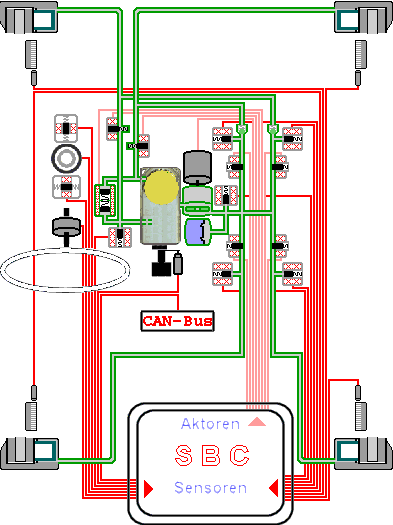
| SBC is a direct pressure rationing system |
Basically ABS, ESD etc. are only add-ons to the existing hydraulic system. They reduce, depending on the situation, any excessive brake pressure generated by the driver. It would be more effective, to measure the
behaviour of each wheel exactly and to apply the suitable brake pressure necessary for the driving situation directly. This is exactly what the electro-hydraulic brake (Sensotronic Brake control) does, a braking activity
controlled by electric sensors.
| Many advantages concerning comfort and above all, safety |
Direct advantages are recognizable. Thus a parking brake can be automatically released, e.g., when pulling off on a hill. The actual braking process can be automated. This means a steady slowing down right up to a
standstill or stronger braking if the brake pedal is pressed quickly, but not decidedly enough. The braking process may even already be initiated after a sudden release of the accelerator pedal, improving the response
time. One of the safety features is the steady, dry braking in wet conditions. For the sake of comfort, sudden stopping can be softened at the end of the brake process.
The, for beginners, irritating vibrations which occur when the ABS function is switched on, now no longer appear. Of course all other functions, for example, the electronic differential lock, the electronic stability
programme or the adaptive speed regulation can be integrated into this system. Future add-ons can be integrated easier. The application of this system in connection with power-saving hybrid vehicles is especially
important. With just a light pressure on the brake pedal, electric current can be generated instead of the energy 'destroying' braking process.
| In an emergency only the front brakes are used |
Of the original, hydraulically operated brake only an emergency connection remains for both circuits to the front axle. It is normally closed. The pedal-travel transducer and the pressure generated by the pedal serve as
signals for the control device. So as not to confuse the driver too much, a counter-pressure is simulated in the main brake cylinder (pedal). Now the way is free for a regulated braking system controlled by an electric pump
and accumulator (max. 160-180 bar) which through magnetic valves, works on all four wheels. In the control circuit the stock pressure and the single pressures are supervised and corrected constantly.
| Additional braking pressure (Sensor) and braking simulation (Actuator) |
SensorsStock pressure, brake pressures in the single wheels, wheel speeds, accelerator pedal position (CAN-Bus), vehicle movements (length-, crosswise), steering angle, engine speed (CAN-Bus), perhaps gearbox
data (CAN-Bus).ActuatorsMagnetic valves for the wheel brakes, magnetic valves to the front wheel brakes (emergency), brake pressure simulator.
| Complicated system, changing of brake pads is dangerous for home mechanics |
The system is rather complicated. The immediate pedal brake pressure is not used, but rather counter-pressure is simulated, and finally pressure is created by a pump and led to the brake assembly. Many of the functions
can be had cheaper, as partial functions in other systems. Is SBC half-way to the fully-electric brake? Daimler has, in the meantime, won the battle against the teething problems. The Toyota Prius 2 was introduced completely without problems.
Important
Work, e.g., on the wheel brakes is only possible if the system has been deactivated before through a connection to the control device. 11/08